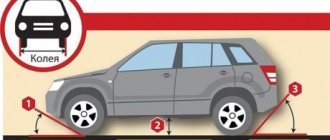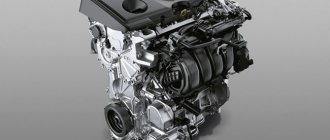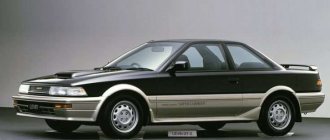Dimensions of Toyota RAV4
Body dimensions are one of the most important parameters when choosing a car. The larger the dimensions, the more difficult it is to control in an urban environment, but the safety is higher.
The body dimensions of the RAV 4 2012 are 4570 mm in length, 1845 mm in width and 1670 mm in height. The dimensions of the new model are not much different from the previous version. The only exception is the height, which has decreased by 25 mm. The wheelbase is 2660 mm.
The weight of the vehicle depends on the selected configuration:
- 2.0 MT 2WD (Standard, Classic) – 1540 kg;
- 2.0 CVT 2WD (Standard Plus, Standard, Comfort Plus) – 1575 kg;
- 2.0 MT 4WD (Standard, Comfort) – 1610 kg;
- 2.0 CVT 4WD (Standard, Elegance, Prestige, Comfort Plus, Elegance Plus, Prestige Plus) – 1645 kg;
- 2.2TD AT 4WD (Elegance, Prestige, Standard, Elegance Plus, Comfort Plus, Prestige Plus) – 1715 kg;
- 2.5 AT 4WD (Elegance Plus, Prestige Plus, Comfort Plus) – 1685 kg.
The ground clearance for this model is 165 (for 2.5 AT) and 197 (for 2.0, 2.2) mm. A loaded car loses 2-3 cm of ground clearance.
Exterior and interior
In the photo, the 2012 RAV 4 looks more modern compared to the previous model range. The appearance seems aggressive and angular, there are no longer the usual rounded shapes.
The front of the car looks too busy due to the three radiator grilles. The headlights, regardless of configuration, seem outdated, and the daytime running lights are very small. The disk design is simple and uninteresting.
The horizontal rear lights, lowered roofline and reduced side glass area make the car look stylish and sporty. The spare tire is now hidden in the trunk. It's no longer full size.
The interior of the Toyota RAV 4 is quite attractive. The creators have maintained continuity, but the interior does not seem outdated. The two-level front panel, remembered by customers for its practicality, is reminiscent of past generations.
The second row of passenger seats does not have additional amenities. There is no heating for those sitting in the back.
The crossover has fabric upholstery. You can choose black, grey, beige or terracotta.
Some trim levels have acquired seats trimmed with Soflex leatherette (“Elegance”, “Elegance Plus”, “Prestige”).
There are versions with two-tone interior trim and carbon fiber inserts.
The trunk is not happy with the materials. The floor is very thin and the frames are made of hard plastic that is prone to scratches. The luggage compartment volume is 506 liters. In the “Prestige Plus” configuration – 577 liters.
The car is equipped with a 6.1-inch color touchscreen display. All trim levels have AUX and USB connectors.
The overall layout of the dashboard remains virtually unchanged. Among the innovations: additional LCD indicator windows have been added, the microclimatic panel has been completely redesigned.
Let's summarize
The RAV4 is traditionally good. It is even capable of moving on simple off-road conditions, which is helped by the rigid locking of the center differential. But it’s unlikely that the third rider is capable of independently climbing the Karaarsha pass, where I once drove a first-generation car.
— Toyota RAV4 after restyling in 2010 is no longer perceived as an exclusively women's car. It seems like we only worked with shapes and lines, but the mood changed
Will the next, fourth generation be conceptually different? We will, of course, wait to see it, but let’s assume that it will only improve its performance for the city, become more noble in the interior, and at least, just in case, will retain the center lock. Fortunately, the meeting with him will take place very soon.
Engine and transmission
Under the hood of the Toyota RAV4 2012 there is powerful and reliable hardware. There are two petrol power units and one diesel available to choose from:
- 3ZR-FAE is a 2-liter four-cylinder engine that runs on gasoline and has a power of 148 horsepower. Basic version.
- 2AD-FTV – runs on diesel. It has a power of 150 forces and a volume of 2.2.
- 2AR-FE - a 2.5 liter petrol power unit with a power of 179 hp. Replaced the 2.4-liter engine.
There are three transmissions: manual transmission, automatic transmission and CVT. Mechanics and a variator are installed on cars with two-liter gasoline power units.
More powerful models are equipped with an automatic transmission.
Milestones of history
The very first RAV4 appeared in 1994, causing a sensation in the global market. Of course, this car opened up a completely new market segment - crossovers. The first rafik did not have many versions and options, as it does now. There is only one engine, a two-liter, but of different power: 128 and 165 hp. But there were two bodies at once: a three- and a five-door, and a little later a convertible based on the short version appeared.
1994 - first generation Toyota RAV4
2000 - second generation RAV4
2005 - third series of Toyota RAV4
In 2009, the third rafik was significantly modernized
The fourth generation Toyota RAV4 was introduced in November 2012
In 2000, the second generation RAV4 was released. The car was no different from its predecessor in any way, although there was no longer an open version. The base engine has become more powerful - 150 hp, and a 1.8-liter gasoline engine and a two-liter turbodiesel have also been added to it. The second generation was produced until 2005.
The third driver received a new body and different engines. The three-door modification disappeared forever, and in its place a version of the basic five-door body, extended by 210 mm, appeared.
In 2009, the third generation RAV4 underwent its first restyling. The changes, however, were minor. But during the modernization in 2010, the car received new optics, radiator grille, hood and other changes. In November 2012, the fourth generation Toyota RAV4 was introduced to the world.
Specifications
Two types of drive are available: front-wheel drive (FF) and all-wheel drive (4WD).
Characteristics of Toyota RAV 4 with engine capacity 2.0:
- Engine location – front, transverse. Working volume – 1988 cubic cm. Engine power system – distributed injection.
- The suspension of the front and rear wheels is independent, spring. Tire size – 225/65. Disc radius – R17.
- Front brakes are ventilated discs. The rear ones are disc.
- Acceleration to 100 km/h takes 10.2 seconds for the front-wheel drive model, 10.7 for all-wheel drive.
- The maximum speed is 180 km/h.
Gasoline consumption on city roads is 11.6 liters, on highways – 6.9 liters, and in mixed mode only 8.6 liters. Recommended fuel is AI-95. Fuel tank volume – 60 l.
Did not like:
- Pleasant operation of the gearbox The variator works well and does not slow down much. In Sport mode there are no complaints at all.
- rich equipment. Everything is there. The only thing missing is a radio with a display. However, all this is installed quickly.
- energy-intensive suspension Yes, the suspension is noisy, the car on it is rolly and at the same time rigid. But how energy-intensive! Takes blows from our pits like a samurai!
- Cotton steering So far, none of the electric boosters I have encountered have replaced hydraulics in terms of transparency. And the amplifier in the RAV4 was no exception.
- poor sound insulation I will not say that it is bad. It seems that she simply does not exist.
- Miscalculations in ergonomics It would seem that everything is there, but it seems that it has not been thought out. The climate control system is inconvenient to use, and its screen is hidden from view; folding the rear seats requires effort.
View from the outside
My uncle often wonders: how did we live without plastic products? How did you previously manage without plastic bottles, plastic dishes, plastic furniture, household appliances in plastic cases, stationery and other plastic small items and parts? He never found a clear answer to this question. Indeed, it is now simply impossible to imagine life without plastic. It may not be very pleasant to the touch, but it is comfortable, takes any shape, and is inexpensive.
The Toyota RAV4 also prompts similar thoughts. The third generation (and even after restyling) no longer repels male drivers and looks quite nice. The two-liter engine, paired with a CVT, pulls well (of course, plastic things weigh a little) and consumes fuel in reasonable quantities (I got 11.4 liters per 100 km of city mileage). The insides are also like a set of plastic utensils. There are containers for any size: here are cup holders, here is a bottle holder, here is a glove compartment with a funny button for opening and closing. The book doesn't fit? So here’s another glove compartment, larger and more spacious. Box with a double bottom in the central armrest, a niche at the base of the central panel. And what a gorgeous underground space in the trunk! By the way, there is also a “hammock” where you can throw a couple of bags so that they don’t crawl back and forth in the spacious luggage compartment. And there was a place for a full-size spare tire - it was placed on the trunk door. Everything is convenient, easy and understandable.
But any plastic thing has its drawbacks. Either they become deformed in the heat, or they crack in the cold, or they are simply too fragile or have an unpleasant odor. Here plasticity is detrimental. There is a downside to the RAV4 too. The plastic essence manifested itself in mediocre sound insulation and an uncomfortable interior - it is all made of echoing hard plastic. The remaining disadvantages are purely automotive, although this does not make it any easier. The suspension is overly stiff and loud (albeit very energy-intensive), and the gas pedal turned out to be completely inadequate. In normal mode, the pedal does not react at all when squeezing a third of its travel; pressing the Sport button partly saves the situation, but here you have to be careful, because if you turn up the gas a little sharper, an unpleasant jerk cannot be avoided. Two extremes, and the golden mean remains unattainable.
But what more could you want from a mass crossover? The RAV4 is comfortable, roomy, handles well on-road and even a little off-road (all-wheel drive and 180mm ground clearance), and the steering wheel is not intimidating with its absolute emptiness. In short, as versatile as plastic! But it turned out to be not the cheapest among the Japanese. For that kind of money, I would look for something with a higher content of natural materials. Maybe Hyundai Santa Fe or Nissan Qashqai, or maybe I would wait for the new fourth Toyota RAV4 to appear in Kazakhstan. Look, the plastic there will be not only convenient, but also pleasant.
Pavel Kim
Personal car: travels by metro and gas buses
fan of cars that can be bought without waiting in line
Toyota RAV4 configurations and prices
There are 7 trim levels of Toyota RAV 4 2012 available on the Russian market.
Description of the most common:
- “Standard” - has seven airbags, an immobilizer, electric power steering, traction control, fog lights, heated front row seats, 17-inch alloy wheels, power windows, air conditioning and climate control;
- “Standard Plus” – added rear parking sensors and a leather-trimmed steering wheel with push-button controls;
- “Comfort” - includes climate and cruise control, a moisture sensor, a rear view camera and a six-inch color monitor;
- “Elegance” – adds an electric rear door, leather interior, electric driver’s seat and smart engine start using a button;
- “Prestige” - blind spot monitoring, automatic headlight control, navigation and a tracking system when changing lanes appeared.
In the Plus trim levels, lumbar support appears in the front passenger and driver seats.
The price of a car starts from 900,000 rubles and reaches 1,500,000 rubles. The cost depends on the selected configuration and engine size.










